
The text of the famous Supreme Court decision, Marbury v. Madison, is presented here.
- Subject:
- Social Studies
- Material Type:
- Primary Source
- Provider:
- Department of Alfa-Informatica, University of Groningen
- Date Added:
- 10/03/2023

The text of the famous Supreme Court decision, Marbury v. Madison, is presented here.

Included here are Thomas Jefferson's two inaugural addresses and his State of the Nation speeches. You can follow Jefferson's increased distress concerning the young nation's treatment by European nations. Fascinating reading.

This resource guide helps teachers to use World War I source material from the World War I in Ohio Collection on Ohio Memory in the classroom. The material included in this resource guide engages students with the soldier experience from enlistment and training to service overseas.
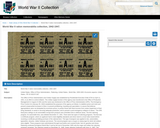
World War II ration memorabilia collection, 1942-1947.
The Office of Price Administration and Civilian Supply was established by Presidential Executive Order 8734 on April 11, 1941, in an effort to control inflation. The civilian supply function of the agency was transferred to the Office of Production Management in August of 1941 and the name was shortened to the Office of Price Administration (OPA). The Emergency Price Control Act (January 30, 1942) established the purposes of the agency as follows: to stabilize prices and rents and prevent unwarranted increases in them; to prevent profiteering, hoarding and speculation; to assure that defense appropriations were not dissipated by excessive prices; to protect those with fixed incomes from undue impairment of their living standards; to assist in securing adequate production; and to prevent a post-emergency collapse of values." The OPA fixed price ceilings on all commodities except farm products and controlled rents in defense areas. The first rationing program, for automobile tires, was initiated December 27, 1941. There were two types of rationing programs. The first was a certificate program, where an applicant had to meet eligibility standards and show need to a local ration board before receiving a certificate permitting purchase of the rationed item. This type of program was applied to ties, automobiles, typewriters, bicycles, rubber footwear and stoves. The second program was a coupon or stamp type for which all civilians were eligible. These programs were administered through local banks and covered foods, fuel oil, gasoline and shoes. Rationing continued throughout World War II and by the end of November 1945 only the sugar and rubber tire rationing programs remained. Tire rationing ceased on December 31, 1945. Sugar rationing continued until June 11, 1947. The Office of Price Administration was dissolved April 1, 1947.
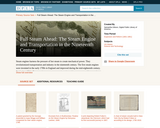
This collection uses primary sources to explore the steam engine and transportation in the nineteenth century. Digital Public Library of America Primary Source Sets are designed to help students develop their critical thinking skills and draw diverse material from libraries, archives, and museums across the United States. Each set includes an overview, ten to fifteen primary sources, links to related resources, and a teaching guide. These sets were created and reviewed by the teachers on the DPLA's Education Advisory Committee.
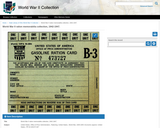
World War II ration memorabilia collection, 1942-1947.
The Office of Price Administration and Civilian Supply was established by Presidential Executive Order 8734 on April 11, 1941, in an effort to control inflation. The civilian supply function of the agency was transferred to the Office of Production Management in August of 1941 and the name was shortened to the Office of Price Administration (OPA). The Emergency Price Control Act (January 30, 1942) established the purposes of the agency as follows: to stabilize prices and rents and prevent unwarranted increases in them; to prevent profiteering, hoarding and speculation; to assure that defense appropriations were not dissipated by excessive prices; to protect those with fixed incomes from undue impairment of their living standards; to assist in securing adequate production; and to prevent a post-emergency collapse of values." The OPA fixed price ceilings on all commodities except farm products and controlled rents in defense areas. The first rationing program, for automobile tires, was initiated December 27, 1941. There were two types of rationing programs. The first was a certificate program, where an applicant had to meet eligibility standards and show need to a local ration board before receiving a certificate permitting purchase of the rationed item. This type of program was applied to ties, automobiles, typewriters, bicycles, rubber footwear and stoves. The second program was a coupon or stamp type for which all civilians were eligible. These programs were administered through local banks and covered foods, fuel oil, gasoline and shoes. Rationing continued throughout World War II and by the end of November 1945 only the sugar and rubber tire rationing programs remained. Tire rationing ceased on December 31, 1945. Sugar rationing continued until June 11, 1947. The Office of Price Administration was dissolved April 1, 1947.

A scanned copy of the 1850 publication of Gems of Poetry for Girls and Boys by Harrison Eastman and Henry Walker Herrick, a book of poetry for children.

A digital collection of advertisements for runaway and captured slaves in the period before the American Civil War. In addition, there are historical documents related to slavery. Gives the option of browsing or doing a detailed search. Includes some teaching materials.

Review the text George Washington's first inaugural address given on April 30, 1789. RI.11-12.8 seminal U.S. texts
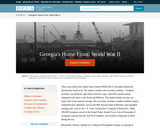
Three years before the United States entered World War II, President Roosevelt declared the South to be "the nation's number one economic problem." Georgia's economy was distinctly agricultural and low-wage, with little manufacturing compared with states in the North and Midwest. The median family income was nearly half of the national average. One year later, an influx of federal defense money established new industries, such as the Bell Aircraft plant in Marietta, and expanded existing ones, such as the J. A. Jones Construction Company in Brunswick. While 320,000 Georgians served in the United States Armed Forces, tens of thousands of Georgians repaired aircraft, built B-29 bombers, and worked in shipyards at home during the war. Meanwhile, military training was widespread throughout Georgia, occupying its fields as well as skies. Capitalizing on the state's flat coastal region and mild winters, Army airfields were installed in Savannah, Statesboro, Thomasville, and Waycross, and pilots trained in Albany, Augusta, Americus, and Douglas. Thousands of soldiers passed through Fort Benning and Fort Oglethorpe, where members of the Women's Army Corps trained for positions at home and abroad. World War II employment was crucial to the economic development of the state, ushering in the transformation to a modern, industrial, and diverse Georgia. This exhibition was created as part of the DPLA's Public Library Partnerships Project by collaborators from the Digital Library of Georgia and Georgia's public libraries. Exhibition organizers: Mandy Mastrovita and Greer Martin.

This resrouce gives the text of Gerald Ford's State of the Union Address in 1977.

Check out this site for a brief history of the Watergate scandal & the text of President Ford's speech announcing his official pardon of Richard Nixon. You can access an audio clip of the speech as well as view the original written document.

The response to the Nuremberg Laws by the National Representation of the Jews in Germany, September 24, 1935.

Links to four documents in which Adolph Hitler justifies his invasion of Poland and his response to Great Britain's objection to that act. Very interesting reading.

At this site from the Nobel e-Museum you can download and read Gertrude B. Elion's Nobel Lecture, "The purine path to chemotherapy." This lecture, originally given by Elion on December 8, 1988, is available in pdf format.

This site gives the full text of Lincoln's "Gettysburg Address."

This is a complete glossary of cartographic terms pertaining to maps of the United States.

This collection uses primary sources to explore the golden age of musical theatre on Broadway. Digital Public Library of America Primary Source Sets are designed to help students develop their critical thinking skills and draw diverse material from libraries, archives, and museums across the United States. Each set includes an overview, ten to fifteen primary sources, links to related resources, and a teaching guide. These sets were created and reviewed by the teachers on the DPLA's Education Advisory Committee.
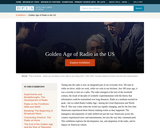
Tuning into the radio is now an integrated part of our everyday lives. We tune in while we drive, while we work, while we cook in our kitchens. Just 100 years ago, it was a novelty to turn on a radio. The radio emerged at the turn of the twentieth century, the result of decades of scientific experimentation with the theory that information could be transmitted over long distances. Radio as a medium reached its peakåÑthe so-called Radio Golden AgeåÑduring the Great Depression and World War II. This was a time when the world was rapidly changing, and for the first time Americans experienced those history-making events as they happened. The emergence and popularity of radio shifted not just the way Americans across the country experienced news and entertainment, but also the way theyåÊcommunicated. This exhibition explores the development, rise, and adaptation of the radio, and its impact on American culture.

The text of the legal document granting the province of Maine to Sir Ferdinando Gorges and John Mason in 1622.